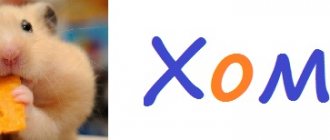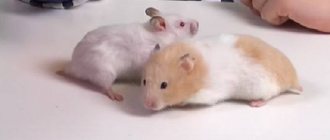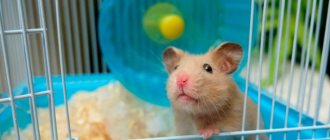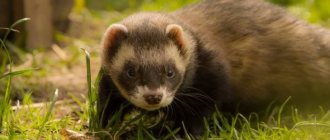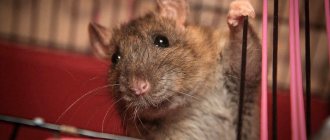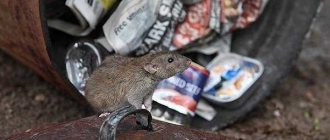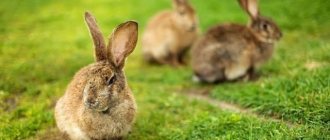Review author: “ZooVita”
Degu, which has a second name - bush squirrel, is a rodent that is widespread in Bolivia, Peru, Chile and Argentina. Living in natural conditions, the squirrel prefers rocky surfaces overgrown with vegetation.
At the moment, thanks to the funny appearance, which can be seen in the photo of the Degu squirrel, activity and friendliness, they began to keep it as a pet. Domestic Degus very easily get used to people and take root in their homes.
Degu - TTX of squirrel (domestic squirrel)
The Chilean degu squirrel is an interesting and cute animal that can be kept at home. In appearance, it is a small squirrel with a short and dense neck, a round head, a flattened nose, and a slightly hunched back. The hind legs are several times longer than the front ones, and there is a beautiful tail with coarse fur.
The color of the squirrel is often gray-brown, with a light yellow or orange tint. The length of the squirrel including its tail is no more than 40 cm, and it weighs up to 280 grams. When kept at home, these indicators may change.
Chilean squirrels, unfortunately, are not long-lived; their lifespan is 4 years. If they follow all the rules of care and maintenance, they can live up to eight years in captivity. The main thing is to love and protect your pet from stress and injury.
The degu squirrel has an excellent sense of smell, hears sounds perfectly, but sees only at close range. A special sensory organ, vibrissae, helps it navigate in space and thereby avoid injury. Despite its agility and jumping ability, the degu squirrel can break its legs or dislocate them.
Reproduction
The mating season of the bush squirrel continues from late winter to mid-autumn. During one year, a rodent can produce offspring a maximum of two times. For squirrels living in captivity, the mating season is not tied to the seasons.
A female Degu can become pregnant again immediately after giving birth, but this can lead to the death of the squirrel or its offspring. Gestation of baby squirrels occurs over a period of three months.
Feeding with mother's milk, on average, 6 babies born, occurs over the course of four weeks. Parents also feed the squirrels with fresh vegetation.
Behavior
The behavior of degu squirrels when kept at home varies. They are cheerful, often even tame animals, but they are naturally shy and therefore behave warily, especially around people. There is no need to scare them with loud sounds, bright lights, grab them by the tail or sneak up from behind. A degu can jump up to 1 m in height and this is worth remembering, since if it is frightened, it can jump in the cage and get hurt.
Habitat territories
Degu squirrels living in burrows have chosen South America as their habitat. They prefer desert or rocky areas, but can live in swampy and wooded areas. They can also settle in floodplains.
Content
Once you have a squirrel at home, you should keep it in a cage. If it is spacious, the squirrel will be comfortable in it. You cannot let them run around the apartment, as they chew everything they come across - shoes, wallpaper, doors. They live in families, so they cannot stand loneliness, the only way out is to get them a mate or breed them. Sand baths are their weakness, and to do them you have to frequently clean around the cage and be prepared for sand to be everywhere.
House maintenance (cons)
- The squirrel gnaws everything it comes across;
- Cannot stand loneliness;
- Frequent colds;
- Sand baths;
- Compliance with diet;
- Cleaning the cage.
Life in nature
Degu squirrels live in families and usually there are 1-2 males, up to 6 females with 5-10 cubs. They build their burrows all together, reaching an area of up to 200 square meters. meters. When digging a home, they work harmoniously, forming a chain, and transfer earth to each other from the depths to the surface. Thus, they dig entire tunnels and live calmly, warmly, without fear of attack by birds of prey. They do not allow strangers into their territory and protect their space and even family members in every possible way.
Degus are very thrifty animals; there is always a supply of food in their home. Prepare for winter in advance.
A female can give birth twice in a year, but at home this happens more often. The mother feeds the cubs with milk for up to 6 weeks and makes sure that they do not leave the hole. If the cub escapes, the mother immediately returns it to the hole. Males actively participate in raising small squirrels, constantly monitor food, carry fresh grass and take care of them. They lead a daily lifestyle in normal life. They live in Peru, Argentina, Chile, where there are a lot of bushes and rocky terrain.
Feeding
The main rule when feeding degus is to follow a diet and exclude sweets and fats from the diet. Treats - cookies, fried nuts, food from the human table - all this should absolutely not be given to degus. Squirrels do not eat meat; they are vegetarians from birth; their food is fresh grass, plant roots and seeds. Now all this can be purchased at pet stores and some even in regular grocery stores. You should not overfeed the animal, it is better to give it portionwise - no more than 30% of the weight at a time, and so on 2-4 times a day.
Important! If you refuse food for more than a day, you should seek help from a doctor.
Rodent diet
An approximate daily diet for a degu squirrel is grain food with the addition of berries or herbs, a quarter of an apple, 3-4 pieces of carrots, 40-50 grams of white cabbage, 10 grams of muesli or raisins.
What can you feed
- Fruits (apple, banana, pear);
- Vegetables (cabbage, carrots, tomato, cucumber);
- Grains;
- Rusks;
- Dry peas;
- Hay (required, must always be available in the cage).
All products must be at room temperature and fresh.
What not to do
- Dairy products;
- Overripe and unripe vegetables and fruits;
- Homemade food;
- Fish, meat;
- Canned foods;
- I love any baked goods.
Be sure to install a sippy cup, preferably pour boiled or settled water, make sure that the water is not stained. Observe how the animal behaves after a snack; new foods should be introduced in small doses, even those purchased in a specialty store. Frequent scratching of the ears and other parts of the body is a possible sign of an allergic reaction.
Nuances of nutrition
The “menu” of the Degu squirrel consists of: all kinds of herbs, including medicinal ones; roots, leaves and flowers of shrubs; plants' seeds; vegetables and tree bark.
Since the squirrel is a herbivore, its diet should contain plant food daily, including hay, leaves and grass. Plant food is necessary for rodents to fully develop.
Housing
Particular attention should be paid to the squirrel’s home. The cage should be spacious - at least 70 cm in height, length and width. It is better to buy an iron cage, as the squirrel will quickly chew a plastic one. There must be a sufficient number of branches, roots and grains in it so that she can constantly gnaw on something.
Squirrels are very active, they need to constantly move, jump... so you can buy a wheel, usually they buy something that is suitable for chinchillas. It is not difficult to independently build small labyrinths and low stairs for active squirrels.
What should be in the cage:
- Hay;
- Sippy cup;
- Filler (wood, paper, pressed sawdust);
- Nest house;
- Wheel.
There is no need to place the squirrel’s home next to a radiator, window, or door. Let it be a quiet, inconspicuous corner where she will feel calm and comfortable, especially at first.
What should not be in a cage:
- A lot of toys;
- Glass;
- Dirt, garbage.
Cage selection, filling
The cage must be at least 60 centimeters in length, width and height. Only stainless steel is suitable as a material; plastic walls will be chewed in an instant. Chilean squirrels are rodents. Equip their home with a sufficient number of tree branches, as well as roots. Degus love to overcome obstacles and hide in various shelters. To meet the need for frequent movement for the Chilean squirrel, it is recommended to install a wheel in the cage. It is better to mount the drinking bowl on the wall, and place separate bowls for each type of food.
The cage should be placed away from direct sunlight, heating radiators and sources of loud noise. Mixtures of compressed corn cobs, rags and white paper are most often used as bedding. This type of animal often develops an allergic reaction to sawdust; its use is unacceptable. The extreme regularity of cleaning the cage is monthly, it is better to do it once a week.
How to tame
It is easier to tame an immature individual, since with age they are more timid towards humans and practically do not make contact. The main strategy is not to rush the squirrel and do not expect quick results.
Before starting your acquaintance, choose a suitable place where there are no wires or holes so that the squirrel simply does not run away from you. First, try speaking quietly to the degu, let the squirrel get used to your voice. The gentle and quiet voice will soon be recognizable to her. Try feeding the animal by hand; of course, don’t expect it to happen right away, everything should be done gradually. Hands should be washed well before feeding, and after too.
Important! Never pick up a squirrel from above; in nature, they are attacked by birds of prey in this way, so your pet can suddenly turn into an aggressive animal and begin to defend itself.
Diseases and prevention
The degu squirrel requires special attention to its health. The first signs of health problems are the eyes and teeth. If the teeth begin to turn white, then reconsider the pet’s diet; if spots appear on the eyes, the help of a veterinarian is required.
Frequent diseases of degus
- Conjunctivitis. This is a purulent and inflammatory process of the eyes, seek help from a veterinarian in this case for treatment;
- Cataract. More often this can be found in squirrels over the age of 6 years, a white spot on the brown background of the eye;
- Diabetes. This is perhaps the most common degu ailment. It manifests itself in the animal's lethargy, excess weight, and constant thirst. It cannot be cured, but can be avoided by following feeding recommendations;
- Colds. Degu does not tolerate temperature changes and drafts. Pay attention to the eyes - if they are watery, then the squirrel is sick. Also, mucus in the nose and apathy are signs of a cold. You can treat with a decoction of rose hips and calendula, but do not overdo it;
- Tumors. Especially in old age, this is associated with metabolic disorders.
Health
Proper care and good conditions in which Chilean squirrels are kept are the key to a long and happy life. A healthy animal is easy to distinguish from a sick one. He has a good appetite, he is cheerful, active and “tests his teeth” with the whole world around him with great interest. Sometimes literally. Of the serious diseases, degus are most susceptible to diabetes, which occurs as a result of poor nutrition and obesity. Females especially often suffer from it after the birth of babies. Therefore, as a preventive measure, it is necessary to give a certain level of stress to the young mother, and, of course, feed her correctly.
The normal weight of an adult degu is 300 grams. If it is taller, and visually, the belly protrudes strongly, then this animal has a high risk of serious illness. Degus are very clean animals; they do not cause problems to their owners. However, providing good conditions for keeping them will require certain material costs.

